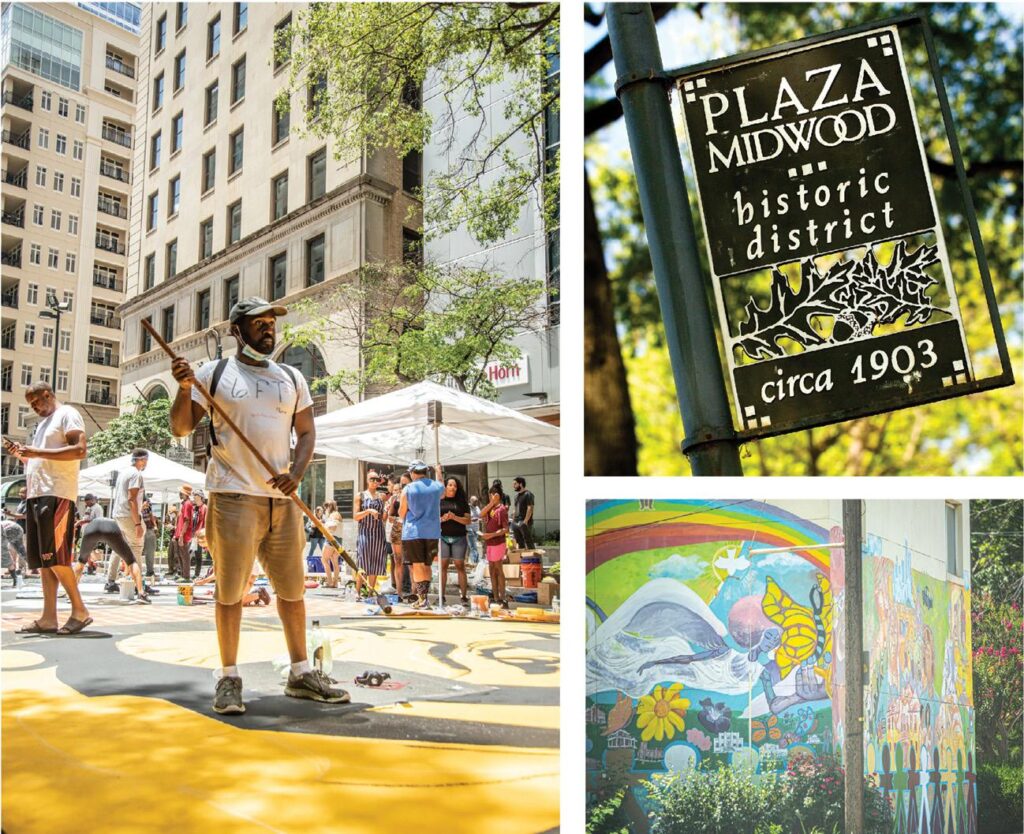Home / 03. Policy Framework / Goal 9: Retain our Identity and Charm
Plan Policy
Table of contents
Goal 9: Retain our Identity and Charm

Goal 9: Retain our Identity and Charm

Charlotte will retain the identity of existing neighborhoods by intentionally directing redevelopment, limiting displacement and cultivating community-driven placemaking that elevates the importance, quality and design of places.

Objectives
- Increase the rate of restoration and adaptive reuse of existing structures originally built for commercial uses and reduce the rate of tear downs.
- Increase the number of publicly funded placemaking and art installations throughout the City, especially within older neighborhoods and areas with populations vulnerable to displacement.
- Reduce the speed and scale of older homes and existing trees being demolished and replaced with newer homes in existing neighborhoods, homes within historic districts, and homes within the Old Historic Route 4 Survey area.
- Reduce the number of residents experiencing involuntary displacement.
- Improve jobs-skills match in and near areas with residents who may be vulnerable to displacement.
- Preserve and improve the tree canopy in Charlotte as an important part of the city’s character.
- Increase the capture of new jobs within “work” Place Types proximate to neighborhoods with owners and tenants who may be vulnerable to displacement.
- Provide financial and technical support to small businesses in areas at high risk for commercial displacement.
- Increase the percentage of new jobs and households in Regional and Community Activity Centers.
- Increase the capture of new jobs within Regional, Community, and Neighborhood Centers adjacent to neighborhoods with owners and tenants who may be vulnerable to displacement.
- Identify, catalogue and understand the patterns of the character defining elements in neighborhoods and places that are uniquely Charlotte.
- Increase the number of historic districts that preserve a wide range of Charlotte’s diverse history and character.
Big Policy Ideas
- Protect Naturally Occurring Cultural Districts (NOCDs), especially in underserved neighborhoods, established neighborhood serving commercial areas, and ETODs.
- Become a leader in neighborhood-influenced placemaking, public space, public art and other cultural installations.
- Explore reduced parking requirements and shared parking to allow adaptive use of historic buildings and significant character areas.
- Protect trees throughout the city during the development process, including infill projects.
- Continue to coordinate historic preservation ordinances with the City’s fire code and building code.
- Prioritize protection of neighborhoods highly vulnerable to displacement through the mapping of Place Types and associated zoning districts.
- Support adaptive reuse of historic structures through a variety of tools, such as tax abatement programs, revolving funds to support preservation, grant and education programs, incentives for energy efficiency, and tax credits for historic properties.
- Explore implementation of “neighborhood character” overlay zoning in appropriate neighborhoods to reduce or mitigate changes to community character, while balancing needs to diversify the City’s housing stock.
- Encourage preservation and adaptive reuse of existing structures through strategic flexibility of development regulations.
- Promote the reuse and redevelopment of under-used surface parking lots to support the expansion and creation of local businesses.
- Elevate public realm and architectural design standards to reflect the culture and history of the community in existing and new places.
- Mitigate neighborhood-defined cultural displacement through support and incentives for local businesses, markets, and community amenities and funding to support artwork placed through the City’s Public Arts Program (enabled by the Public Art Ordinance) and the City’s Placemaking Program.
- Within neighborhoods vulnerable to displacement, emphasize essential public amenities and facilities (transit stop facilities, local parks, public open space, bicycle facilities, sidewalks, share-used paths, street lighting, community centers, etc.) through capital improvement prioritization process and in coordination with the County.
- Fully fund a proactive tree care program for public trees.
- In CIP, continue to invest in the installation of planting strips that support large trees through maturity.
- Explore opportunities to support vulnerable neighborhoods such as weatherization and grant programs which enable low-income homeowners to remain in or move into homes and preserve historic structures, when feasible.
- Develop a fund for the maintenance of artworks created through City funding, including the Charlotte-Mecklenburg Public Art Program, the Placemaking Fund, and Capital Improvement Projects.
- Develop a fund for the maintenance and programming of public spaces.
- Continue and expand City and partner grant programs that support neighborhoods and other community organizations to undertake projects aimed at retaining local identity and charm and supporting capacity building of artists.
- Educate community members and City staff (including inspection staff) about regulations and programs that support historic preservation.
- Enhance support of neighborhood planning and engagement to develop “neighborhood stewardship ethos” in all neighborhoods by identifying and empowering residents to be community planners and neighborhood advocates.
- Develop a formal process, such as through Neighborhood Improvement Districts, to support neighborhoods and organizations seeking to improve and enhance neighborhoods and business districts; and provide technical support and guidance for capacity building.
- Develop registries of vacant properties and large surface parking lots and work with property owners to evaluate and encourage beneficial reuse of sites.
- Create a culture of developer-community collaboration through the encouragement or requirement of Community Benefit Agreements.1
- Through infrastructure investment and partnerships, invest in public art within neighborhoods and prioritize installations within vulnerable neighborhoods.
- Formalize a toolbox for restoration and reuse of existing structures, prioritizing historic structures.
- Formalize a process with neighborhoods and Mecklenburg County to program new and existing public spaces with culturally relevant activities.
1 https://vancouver.ca/people-programs/community-benefit-agreements.aspx
- Encourage innovative urban design, placemaking, and preservation strategies along commercial and cultural corridors to maintain and enhance landscapes and public spaces.
- Develop a Preservation Plan that identifies places, traditions, landscapes, and buildings that tell the full story of the City’s history and outlines future direction for celebrating and enhancing the unique physical character, cultural values, and social identity of the City.
- Support public outreach efforts to notify residents of vulnerable neighborhoods of City programs of programs that help avoid displacement, such as aging-in-place programs.
- Provide design guidance for infill and redevelopment projects in Charlotte’s historic neighborhoods and other cherished places.
Recommended Projects and Programs
- Cultivate placemaking and local culture by continuing to fund the Placemaking Program and allocate 1% of capital project budgets for public art from local, regional, and national artists.
- Consider increasing the percentage of capital project budgets devoted to placemaking and public art to further support placemaking, development of public art installations and capacity building for local residents, designers and artists.
- Develop a vacant properties registry and program to work with landowners to repurpose sites.
- Develop a program to encourage the development of infill small-scale single-family and duplex residences that meet the City’s desired form requirements.
- Develop a community design handbook to guide redevelopment of Charlotte’s cherished places that are not protected by a historic district designation and associated guidelines.
- Develop a monitoring system to track redevelopment in historic areas and neighborhoods vulnerable to displacement.
- Provide financial and technical support to small businesses in areas at high risk for commercial displacement.
- Complete final survey of remaining five historic neighborhoods identified in Historic Route 4 Study.
- Implement the maintenance recommendations for public art identified in the Art Conservation Report (produced in 2015 by RLA Art and Architecture Conservation) by funding maintenance of publicly-owned art installations.
- Expand upon previous mapping efforts to develop a map of public and privately developed art throughout the City that is accessible to the public.
- Expand technical assistance to residents who want to develop more detailed understanding and guidance in identifying assets, preserving and creating places, and documenting the character of their community.
- Develop and support a low-income assistance program that would aid in tree preservation and care for trees on private property.
The Chicago Prize, an award established by The Pritzker Traubert Foundation (PTF), awarded $10 million in grants to community-led initiatives that invest in the revitalization of neighborhoods and the retention of businesses and residents on the South and West Sides of Chicago. Improvements in both physical conditions and civic infrastructure are intended to increase the economic and social benefits for the community. The City works with the awardee group and Chicago’s neighborhoods to assist in implementation of proposed ideas.

Image source: Getty Images
New York City has been a leader in creating unique neighborhoods throughout its history, however keeping the individuality has been an important topic in recent discussions. With a commitment to keep its neighborhoods special as prices increase, Naturally Occurring Cultural Districts NY (NOCD-NY) were created as an alliance of artists, neighborhood leaders, activists, and policymakers committed to revitalizing New York City from the neighborhood up. Capitalizing on the vibrant culture that already exists in their communities, leaders are standing up for racial justice, environmental justice, immigrant rights, and economic justice to make their neighborhoods even better. The City helps facilitate workshops and focus groups, makes critical links to citywide plans and policies, and provides other tools and resources.
